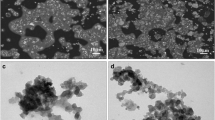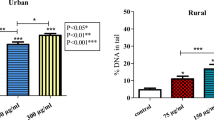Abstract
Object: Detecting the influence of six main ingredients of PM2.5 mineral dusts on the A549 cell morphology, proliferation inhibition rate, micronuclei, and DNA damage to explore the genotoxicity of PM2.5 mineral dusts.
Methods: (1) After exposure to six kinds of dusts of 200 μg mL−1 concentration for 24 h, the morphology of A549 cells was observed with Wright-Giemsa staining. (2) After exposure to different concentrations of mineral dusts for 24 h, the proliferation inhibition rate of A549 cells was detected by MTT assay. (3) Cells were exposed to PM2.5 mineral dusts at a concentration of 200 μg mL−1 for 24 h. After Wright-Giemsa staining, the rates of micronucleus cells were counted under oil immersion lens. (4) Observe Comet phenomenon by single-cell gel electrophoresis (SCGE). The degree of DNA damage was observed by OTM.
Results: (1) Compared to the control group, membrane destruction, nuclear pyknosis, and mineral surface adhesion were mainly seen in the Sericite group and Albite group. In the Quartz group and Montmorillonite group, Cell gap grew bigger, which was loosely arranged and shrank gradually than control group, showing the absorption of a large number of minerals on the cell surface. (2) The proliferation inhibition rate of the six kinds of dusts to A549 cells was (in descending order): KWC-M > Nano-SiO2 > KWC-S > KWC-Q > KWC-A > KWC-C. The dust concentration was positively related to the inhibition of cell proliferation rate. (3) As the dusts’ concentration increased, the incidence of micronuclei gradually increased. The rate was positively correlated to exposure concentration. (4) The six mineral dusts can damage DNA of the A549 cells by dose–response relationship. The higher concentration of the mineral dusts was, the more obvious the DNA damage became.
Conclusion: The six main ingredients of the PM2.5 mineral dusts can change A549 cell morphology in different degrees, improve proliferation inhibition rate of the cells, increase the number of micronuclei cells, and damage DNA. Then we come to the conclusion that PM2.5 mineral dusts can change the genotoxicity of the cells possibly.
Project supported by the State Key Program of National Natural Science of China (NO. 41130746), and the State On national natural fund project (NO. 41472046).
Access this chapter
Tax calculation will be finalised at checkout
Purchases are for personal use only
Similar content being viewed by others
References
Gillissen A, Gessner C, Hammerschmidt S et al (2006) Health significance of inhaled particles. Dtsch Med Wochenschr 12:639–644
Kolling A, Ernst H, Ritting S, Hausen U (2011) Relationship of pulmonary toxicity and carcinogenicity of fine and ultrafine granular dusts in a rat bioassay. Inhal Toxicol 23(9):544–554
Ballester F, Rodriguez P, Iniguez C et al (2006) Air pollution and cardiovascular admissions association in Spain. J Epidemiol Community Health 4:328–336
Valko M, Rhodes CJ, Moncol J et al (2006) Free radicals, metals and antioxidants inoxidative stress-induced cancer. Chem Biol Interact 160(1):1–40
Pope CA III, Burnett RT, Thun MJ et al (2002) Lung cancer, cardiopulmonary mortality, and long-term exposure to fine particulate air pollution. JAMA 9:1132–1141
Chen YJ, Shi ZB, He KB et al (2007) Physico-chemical characteristics of individual mineral particles collected during dust storm periods in Beijing. Res Environ Sci 1:52–57
Dal M, Malak AT (2012) Effects of SiO2 in Turkish natural stones on cancer development. Asian Pac J Cancer Prev 10:4883–4888
Gao N, Keane MJ, Ong T et al (2000) Effects of simulated pulmonary surfactant on the cytotoxicity and DNA-damaging activity of respirable quartz and kaolin. J Toxicol Environ Health A 60(3):153–167
Yauk CL (2004) Advances in the application of germline tandem repeat instability for in situ monitoring. Mutat Res 2:169–182
Berman DW, Brorby GP, Sheehan PJ et al (2012) More on the dynamics of dust generation: the effects of mixing and sanding chrysotile, calcium carbonate, and other components on the characteristics of joint-compound dusts. Ann Occup Hyg 7:852–867
Zeng YL, Gan SY, Dong FQ et al (2012) Study on correlation between the erosion Characteristic in organic acid with the V79 cell toxicity of chrysotile asbestos and its four major substitute fibers. Mod Prev Med 12:2938–2940
Boriana KA, Yigal E, Amir S et al (2009) Mineralogical and chemical characterization of suspended atmospheric particles over the east Mediterranean based on synoptic-scale circulation patterns. Atmos Environ 25:3963–3970
Author information
Authors and Affiliations
Corresponding author
Editor information
Editors and Affiliations
Rights and permissions
Copyright information
© 2015 Springer International Publishing Switzerland
About this paper
Cite this paper
Zeng, Y., Huo, T., Dong, F., Wang, L., Deng, J. (2015). The Study on Genotoxicity of PM2.5 Mineral Dusts to A549 Cells. In: Dong, F. (eds) Proceedings of the 11th International Congress for Applied Mineralogy (ICAM). Springer Geochemistry/Mineralogy. Springer, Cham. https://doi.org/10.1007/978-3-319-13948-7_46
Download citation
DOI: https://doi.org/10.1007/978-3-319-13948-7_46
Publisher Name: Springer, Cham
Print ISBN: 978-3-319-13947-0
Online ISBN: 978-3-319-13948-7
eBook Packages: Earth and Environmental ScienceEarth and Environmental Science (R0)




